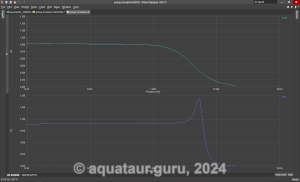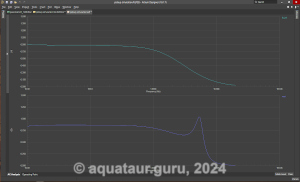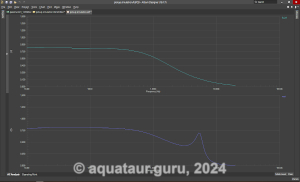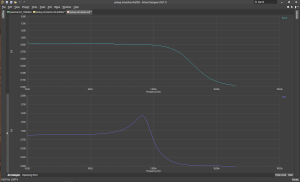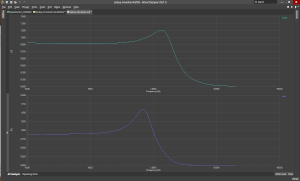|
A Look At
Filter Preamps: Do You Need one? Revoicing A Bass Pickup With The Exemplary Usage Of PassinWind PW3B-LPF last update: July 12, 2024 Copyright 2024-25 by
H. Gragger. All Rights Reserved. All information
provided herein is destined for educational and
D.I.Y. purposes only. Commercial re-sale,
distribution or usage of artwork without explicit
written permission of the author is strictly
prohibited. The original units with their
associated trade-names are subject to the
copyright of the individual copyright or trademark
owner. The Author is by no means affiliated with
any of those companies. References to trade names
are made for educational purposes only. By reading
the information provided here you agree to the Terms
of Use. The working language
is kept in English as an aid. Read here
why.
|
|||||||
| MAIN PAGE>MUSIC STUFF>PASSINWIND Index   Introduction Introduction  (Re-) Voicing A Pickup With
"Filter" Pre-Amps (Re-) Voicing A Pickup With
"Filter" Pre-Amps  SPICE Graphs SPICE Graphs Verdict Verdict Reference Reference  Update
History Update
History   Back To Index Introduction Fuelled by the recent interest in
bass
pre-amps, the Author was intrigued by
the PassinWind
bass pre-amp, developed by Charlie
Escher. This is an excellently done
open-source unit which falls under the
category "filter pre-amp". The Author was not
aware in his 40+ years of engineering
experience that such a classification existed.
Filter preamp is a totally non-technical term coined by the music making community (presumably comprised of laymen in majority; see a discussion on Talkbass) in an attempt to distinguish them from simple passive cut only filters. Filters of course in a technical sense they all are, but higher order filters have the capability to superimpose a character or sonic signature onto the signal - hence the term voicing. So let's for the moment assume they are real McCoy filters, while the others are considered mere, well.... [rolling eyes] Comparing the published V2 drawings with V4 drawings the Author found a few things that did not converge, so he contacted Mr. Escher over that. It appears that those mistakes were victims of the attempt to beautify the drawings for public release. He immediately corrected them, and as of today, the drawings seem correct. Mr. Escher unmistakably expressed that he felt he has dedicated enough of his lifetime to this subject and that he wished to pursue different things. Mr. Escher answered very cordial and was very helpful, and the Author respects and understands his decision. He gave his explicit consent to publishing this document here. In the internet that kind of pre-amp is being traded almost as a wonder-weapon that can potentially coax any revered basses' tone out of a warehouse instrument. Let's look at this using the PassinWind's resonant low pass section as an example. Of course, the same accounts for similar relatively simple technical approaches like a SVF (unlike a complex unit as Alembic's SF-2 which plays in a completely different league). Back To Index (Re-) Voicing A Pickup With "Filter" Pre-Amps While waiting for
some special parts, there was plenty of time to play
with the simulator. Although the Author prefers
measurements, those things cannot be measured anyway.
Somewhere in the course of his long thread on Talkbass.com Mr. Escher has said, that the device was originally destined to live inside a bass; it was only later people that have gone and used it as an external stomp-box. The conventional Baxandall section: Now this has its pitfalls. The Baxandall bass and mid controls are very useful and non problematic. That said, on a different Talkbass thread, somebody uttered Gretchen's question: “Is an EQ pedal absolutely necessary?”. The common answer was about: “only if there were some frequency your overall system does not cater for”. In other words, usually the amp has enough possibilities to shape tone. So this circuit section may introduce functionality already present somewhere else in your signal chain. If the added complexity does not introduce more possibilities, or at least more comfort, it is redundant. This is something to be considered. The second order resonant voicing filter section: The voicing part is a resonant second order low pass. It is called voicing, because a peaking second order low pass gives a pickup its attitude and character. There is plenty of groundwork done on that[1]. An unloaded pickup would not exhibit a strong resonance and thus have a high end roll-off approaching a first order filter. Usually this sounds boring and sterile. Adding a suitable voicing cap will bring down the cutoff frequency and introduce some peaking and give the pickup its "signature sound". Optimally, a series connected hum-bucker, a parallel connected hum-bucker and a single coil receive different voicings, which can relatively easily be incorporated into on-board switching schemes, so that performance switching always yields a useful tone. Although this is simple, it is not done broadly by the manufacturers. The Author has upgraded his basses like that. Most every bass and guitar player has heard of the “C-Switch”, which is nothing more than a series of capacitors with ascending values that does exactly that, but lets you choose one of your liking. Chances are, you stay with that one anyway for a particular pickup. For the reasons mentioned above, it is not guaranteed that a certain finding sounds appealing if applied to a different pickup selection. Gibson have responded to that (way back in time) by introducing something like the C-Switch on their “recording” model of one of their electric guitars, and as the name implies, this is only useful in a recording situation if you have the time for fiddling, and not for stage performance. Adding a lot of versatility also adds a lot of complexion, which is probably why this model did not sell well. Unfortunately, this approach can only bring the resonance frequency down in the spectrum, but not up. A resonant LP filter, regardless of its practical implementation, does basically the exact same thing by an electronic method. However, as different to the passive method, it has full control over the frequency and the peak height, and it can also expand the frequency range of a pickup, in other words, push the corner frequency up in spectrum to an extent. Note: to fully exploit this, the original circuit needs a slight modification. See further down.As said before, more options, more complexity. Stage Performance vs. Studio work: diametrically opposed scenarios What goes without mention is that this method too, is not ready for permanent fiddling during a performance. Likely, you determine a setting and pretty much stay with it. But like its passive counterpart, it is not to be expected that switching pickups sounds good with the same setting. To put it differently, each pickup may require its own voicing. Escher's V4 clearly was a step towards that by introducing modularity. The kind reader will realize by now, that we have not gained anything up til now except huge complexity. The Author cannot stress enough that this all is realistically only possible if the electronics are mounted directly into the instrument, with no other electronic components interfering. Pickup loading and natural resonance What are those interfering things? What is relevant to the pickup, is load. This can be the aforementioned voicing cap that adds to the internal capacity, then all controls, the inevitable cable capacity and the subsequent device’s input impedance. The Author's L-2000 can be switched to “passive”, meaning that the electronics (in this case more or less a buffer) are bypassed. All other controls are active. This is a common and typical setup for a contemporary bass. With this environment, the pickup(s) already “see” a load lower than 250k (typical for Fenders). Without that, the resonant peak would probably be horrendous – and non pleasant. The Author's bass is voiced so that switching from series to parallel is not a punch into the face because of vastly different tonalities by adding caps dependent on the toggle switch states. Now this is elegant, efficient and hard to duplicate by active electronics without undue effort. The series resonance (with a voicing cap) is already pretty low, which is not unnormal for a bass. It is fairly easy to place the roll-off lower and add a new resonance (the existing resonance gets swamped), which largely has the same effect as a larger voicing cap. But one may want to elevate this roll-off a bit towards higher frequencies (something that is not attractive for parallel modes). Actually, replacing the voicing cap with a smaller one would do exactly that, or adding a buffer. Down is easy, up is cumbersome However, the circuit (or any circuit of the kind) is not very effective to shift things upwards. It fights against the laws of physics. The biggest opponent is the existing resonance peak and the sharp second-order roll-off it introduces. As suggested on a Talkbass thread concerning so called filter pre-amps correctly, you can knock down the existing resonance to an extent with a low impedance load resistance in an attempt to flatten it, but this measure may have devastating consequences for a different pickup combination (see pictures below). A higher resonance point can be superimposed, but only of mediocre sonic quality. The reason for this is beyond the scope of this writing. Once semi- satisfactory control settings are found, they will be all wrong if a different pickup (-combination) is activated. Moreover, as soon as you turn the instrument's internal volume down, the effect of the resonance swamping will be nulled on top of that by introducing series resistance. Mr . Escher clearly stated somewhere that he did not attempt to iron out the existing resonance and superimpose a new one. No solution for all situations So, without a hugely invasive modification to the instrument, you cannot find a setting that will work across all pickup combinations on your instrument, if those are very different (like series vs. parallel or single coil). You can, however, still use the low pass as a fairly conventional treble control for frequencies above the internal resonance (since the effect of the filter resonance gets swamped by it) and for resonances below, you can re-voice. The revered SF-2 unit seems to be able to do all this, but with the knowledge gathered so far, this most certainly is not meant to be fiddled with during a performance. One flip of your pickup selector switch, and everything will be way off…SPICE Simulations are based upon the measured values for an L-2000 pickup, series connected coils. Back To Index SPICE Graphs A picture says more than a thousand words. It is time to visualize what has been said.
-Expanding
frequency range (shifting the
resonance upwards), no voicing cap
present-
Pot
Settings on the simulation: res = 600R/10k, freq =
10R/50k (Ohms); lower values = higher Q resp.
frequency
-Expanding
frequency range (shifting
the resonance upwards),
voicing cap present-
Pot Settings on the simulation: res = 100R/10k, freq = 10R/50k (Ohms); lower values = higher Q resp. frequency -Expanding frequency
range (shifting the resonance
downwards)-
Pot Settings
on the simulation: res = 1000R/10k, freq = 15k/50k
(Ohms);
lower values = higher Q resp. frequency
What can we learn from the above observations?
Verdict So to recapitulate: the PassinWind pre-amp, if used as a typical stand-alone box that is preset a certain way and activated by a bypass stomp switch during a performance, will necessarily revert to a fairly conventional low, mid, and high EQ. The instrument’s on-board controls will not interfere, and most likely, you will reach for one of them during a performance before you reach out for the stomp-box's controls. If you set it to a special re-voicing task this will work only for the given instrument setting, and you must not touch any of the controls on your instrument, be it choice of pickups, volume etc. without throwing everything else out of balance with unforeseeable side effects.
Any application that had that in focus would need to be installed inside the instrument or remain reserved for special occasions (like a recording scenario), which would probably be hugely complex for a multi-pickup instrument. You may end up with something like the Gibson Recording guitar, which ended up too complicated to be used for performance. And that guitar "only" contained rotary switches and caps... This work does by no means criticize the PassinWind device, its sonic virtues or its inventor. At this point I like to stress again what Mr. Escher has expressed repeatedly: this unit was never primarily destined to be an external stomp-box. It is thus clearly mis-used if used externally. That all said, nobody will stop you from using it this way, if you like the outcome. The above writings should however bust some myths by clarifying what this unit and similar others can do and what not and under what circumstances. Keep in mind that a unit like this is only vaguely comparable to a SF-2, because the latter likely has the necessary extra filters to iron out a peak and superimpose a new one. But at what cost, financially, by effort, and complexity. Note again that the schematic needs some minor changes in order to accommodate the wide span of possible scenarios of re-voicing purposes as outlined above. Some customizations are outlined in the sequel to this article.The Author's personal conclusion: for overall efficiency and effectiveness nothing can beat a humble voicing capacitor placed with taste and care by a loooong distance. Back To Index Reference [1] Guitar-Letters: a wealth of information on pickups and voicing (in German language), by Ulf Schaedla http://www.guitar-letter.de/Knowledge/CSwitchvsStateVariableFilter.htm and http://www.guitar-letter.de/Knowledge/PickupDatabase.htm Back To Index Update History
MAIN PAGE>MUSIC STUFF>PASSINWIND |
|||||||
MAIN PAGE | MUSIC STUFF | IMPRESSUM  (c) 2024-25 AQUATAUR Musik & Elektronik |
